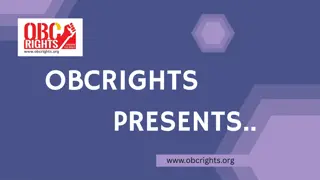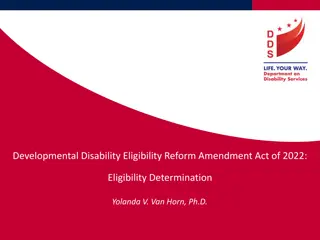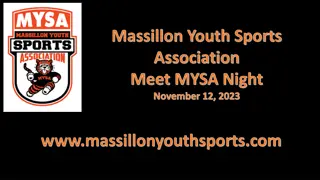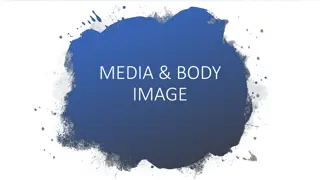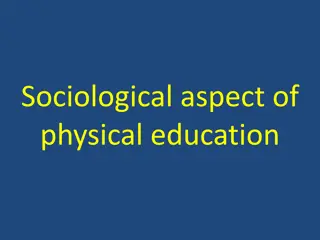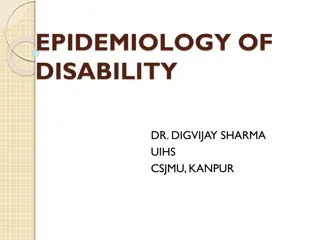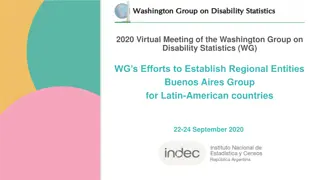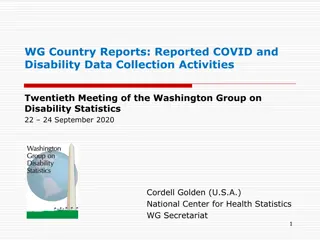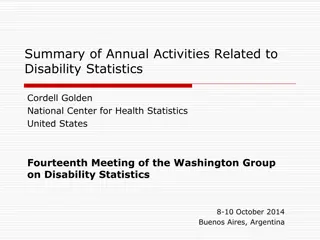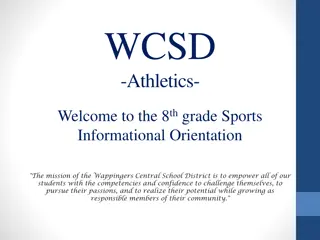Rethinking Disability Representation in Media & Sports
Disability has often been portrayed as a problem, leading to the promotion of supercrip representations that set unrealistic expectations for individuals with disabilities. Overcoming narratives limit the scope of living with impairments, while notions of disability as Otherness perpetuate social myths. Media plays a crucial role in shaping these representations, emphasizing differences and undervaluing similarities in the portrayal of disabled individuals.
Download Presentation

Please find below an Image/Link to download the presentation.
The content on the website is provided AS IS for your information and personal use only. It may not be sold, licensed, or shared on other websites without obtaining consent from the author. Download presentation by click this link. If you encounter any issues during the download, it is possible that the publisher has removed the file from their server.
E N D
Presentation Transcript
NOTES ON SPORT, MEDIA & DISABILITY COMM 412 From Silva & Howe, The (In)validity of Supercrip Representation of Paralympian Athletes
Background Traditionally, disability has been perceived as nothing more than a problem. This understanding of disability is often legitimized through the use of apparent positive narratives of people who overcome their own personal tragedy. When it comes to disability, the baseline reference from which mainstream society assesses the worthiness of an event or performance is normally very low. What is judged as impossible for people experiencing disabilities is often based on distorted assumptions and is not a realistic assessment of such individuals capabilities. Frequently in discourses surrounding disability, people with impairments become super in contexts where an able-bodied individual would be just an ordinary person.
Supercrip representations Those individuals whose inspirational stories of courage, dedication, and hard work prove that it can be done, that one can defy the odds and accomplish the impossible This model involves presenting the disabled person as heroic by virtue of his or her ability to perform feats normally considered not possible for people with disabilities or by virtue of the person living a regular life in spite of a disability. Supercrip representations can imply a stereotyping process that requires an individual to fight against his/her impairment in order to overcome it and achieve unlikely success. Supercrip narratives can be considered to be an expression of society s low-level expectation placed upon people with disability, which ultimately perpetuates the understanding of their existence as a problem.
The problem of overcoming narratives In presenting disability as nothing but a problem, these narratives limit the possibilities of living with impairment in any other way (Morris, 1991). The unquestioned positiveness of overcoming narratives is inscribed in the inviolable package of things naturally taken for granted in a world ruled by an able-bodied majority (Devlin & Pothier, 2006). These overcoming tales are spread in and through all walks of life included but not limited to education, politics, welfare, economics, religions, and sport. The question is whether such praise is always positive.
Notions of disability as otherness To interpret disability as Otherness is frequently a strategy to conceal the impermanence and fragility of observer s own body and to reaffirm one s normality by increasing distance in relation to the outcasts. Media representations are one of the main tools responsible for the perpetuation of social myths around disability, including its construction as Otherness. Media patterns of disability representation have been manufactured alongside an emotional ethos that reproduces the dominant binary abled/disabled. This process can be called Othering the process of magnifying differences and undervaluing similarities. The effect is an increased distance in relation to a certain person who is emotionally and/or sociably undesirable. Language and representation are the main instruments in this process and are also the most pervasive and dangerous oppressive mechanisms for people experiencing disability
Supercrip as a Stereotype Supercrip can be defined as a stereotype narrative displaying the plot of someone who has to fight against his/her impairment in order to overcome it and achieve unlikely success. When uncritically interpreted, this type of narrative can be regarded as positive, contesting dominant views regarding disability as negative and inferior. However, it is the negative ethos of disability that feeds the low expectations placed on the individual labeled as disabled in a way that any achievement is easily glorified, no matter how insignificant. Reinforcing low expectations is what makes supercrip iconography so problematic. Moreover, successes are generally judged in terms of the ability to conform to able- bodied norms. In many cases, the line between an honest appreciation of inspiring achievements and the supercrip stereotype might be very difficult to draw. Not all successful stories are stereotypes. What, then, distinguishes positive, uplifting stories from supercrip narratives?
Paralympics and the (Dis)ability World The sporting global stage offered by the Paralympic Games is a golden opportunity to challenge hegemonic ideals of masculinity, physicality, and sexuality. As Hargreaves (2000, p. 199) states, They [Paralympic Games] also symbolize a challenge to ableist ideology, a reinvention of the (dis)abled body and a redefinition of the possible. In opposition to the dis-abled body, the Paralympic body presents itself as productive, functional, and efficient. A body focused on possibilities instead of limits. Consistent, regular, and high quality exposure of images of efficient impaired bodies can strongly influence social perceptions of (dis)-ability.
Superatleta Image developed to help support the Portuguese participation in the Paralympic Games of Sydney (2000), Athens (2004), and Beijing (2008). The image was intended to represent the human ability to transcend self-limits. By adopting a super logo, participation in disability sport can be promoted as inherently extraordinary.
Freaks of nature Freaks of Nature is the label given to the London 2012 Paralympic marketing campaign launched by the host broadcaster, Channel 4. This campaign started with a weekend devoted to Paralympic sport, during which the documentary Incredible Athletes (presented on August 29, 2011) was the highlight. A way to reclaim the term freaks and utilize it in a positive way.
Translation via media & language Superlative terminology incredible, extraordinary abilities, and amazing athletes. The video is also replete with terminology that essentialize, individualize, and reduce the success of these athletes to features hidden in their bodies: discover the secrets inside their bodies. The close examination, analysis, and dissection of Paralympian bodies through state-of- the-art technology turn their specialness into objects of scientific enquiry. This is the second mechanism at play to build in the presentation of Paralympians as Freaks of Nature. In sum, the search for the hidden secrets Inside Paralympic Athletes stems from a particular view that sporting success is impossible for athletes with impairment unless some special traits exist. However, the adaptations induced by training and hard work are largely responsible for Paralympic athlete s performances. Success is much more grounded in the flexibility and plasticity of our human gearing (body, mind, and world) than in any specific secret inside Freaks of Nature.
Constant comparison/contrast w/ albe- bodied athletes The last mechanism of supercripization that we wish to illuminate is the omnipresent norm of the able-bodied. A continuous comparison seems to be needed to portray different bodies in terms that normal people can understand. But if the able-bodied referential stands as right and beautiful, the empowerment potential of disability sport is weakened. For example, only when compared to an Olympic swimmer does Liz s impairment becomes obvious. But why is the comparison needed in the first place? Why is it interpreted as so exceptional that wheelchair athletes improve their functional abilities by training hard functional abilities by training hard? wheelchair athletes improve their
Contradictions & need for more images Supercrip representations offer a glimpse of hope and visibility in a sporting world ruled by media and marketing, where disability sport is fighting for social acceptance and credibility. Some research on the reception of supercrip images among athletes (Berger, 2008; Hardin & Hardin, 2004), highlight some ambivalence in regards to this iconography. Yet here we must reiterate the idea that, within these studies, the supercrip concept can be understood along a continuum of inspiring stories, which include more realistic ones, specifically the ones that draw more heavily upon stereotypes. Berger s work provides some insight into the positive effects of supercrip examples, accentuating the possibility of personal agency for people labeled as disabled. Successful athletes, in Berger s study, provided important role models for younger athletes to emulate, yet there are negative undertones that can be exclusionary for people who are not motivated by sport or simply do not try hard enough
(Continued) Supercrip narratives feed the illusion that human life can be controlled by human agency; therefore, the hurdles of living with impairment ought to be surpassed by the individuals. The complexity of disability experiences is ignored when one assumes disability can be overcome by individual effort. In order to treat athletes with impairments as true athletes, media coverage must play a crucial educative role in increasing public knowledge on the specificities of the Paralympics, namely, classification, new sports, records, and performances in order to develop an informed and educated audience. The attempt to cover the Paralympic Games in the same manner as Olympics by Channel 4, portraying athletes as Freaks of Nature, may ultimately undermine the intention of equal treatment because it triggers and reinforces representations of disability as freakery and Otherness.
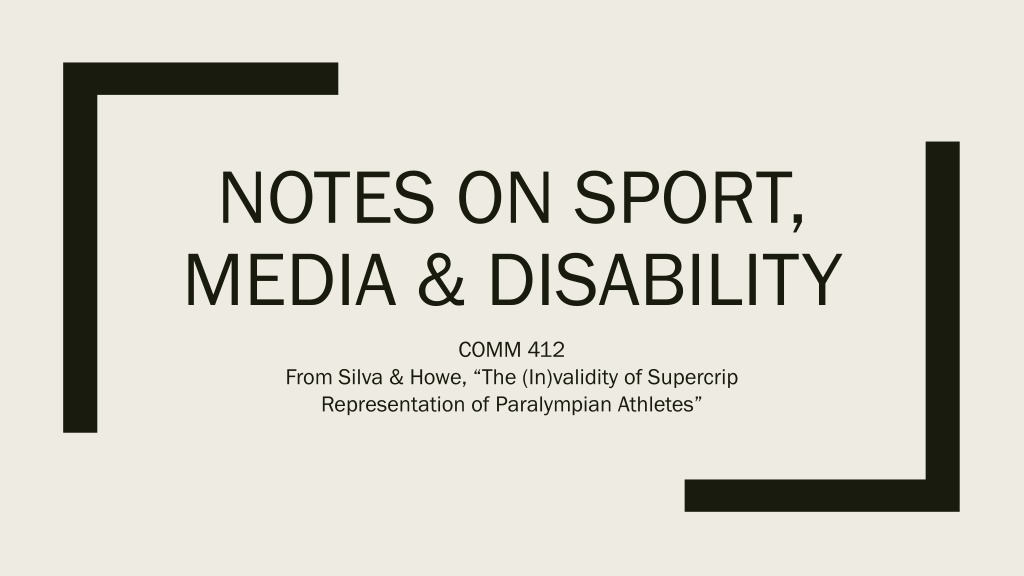
 undefined
undefined






